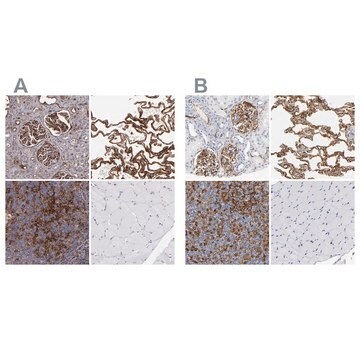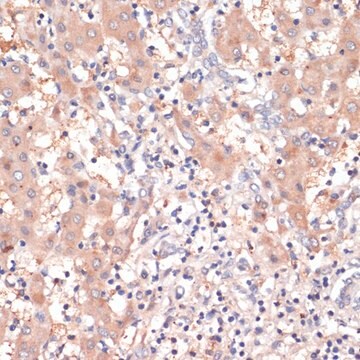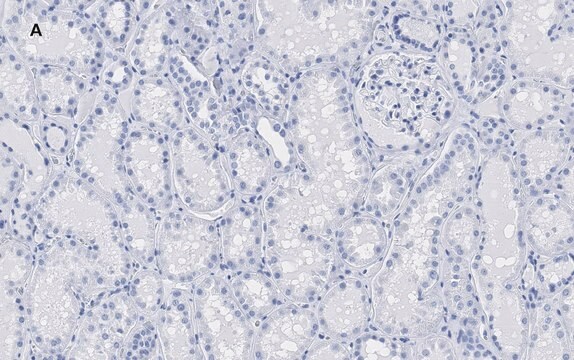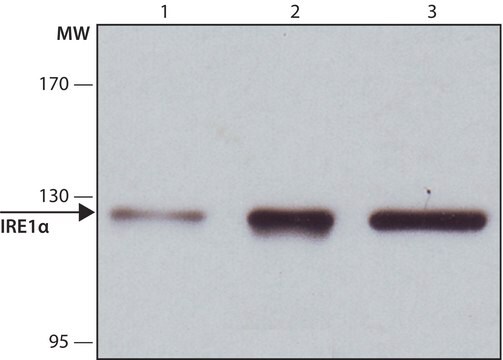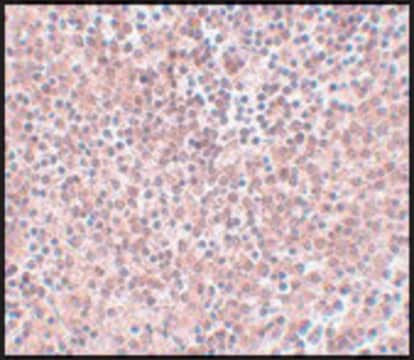推荐产品
生物源
mouse
共軛
unconjugated
抗體表格
purified immunoglobulin
抗體產品種類
primary antibodies
無性繁殖
NNG-811, monoclonal
形狀
buffered aqueous solution
分子量
~40 kDa
物種活性
human
包裝
antibody small pack of 25 μL
濃度
~2 mg/mL
技術
immunocytochemistry: suitable
immunoprecipitation (IP): suitable
indirect ELISA: suitable
western blot: 4-8 μg/mL
同型
IgG1
UniProt登錄號
運輸包裝
dry ice
儲存溫度
−20°C
目標翻譯後修改
unmodified
基因資訊
human ... NANOG(79923)
一般說明
Anti-Nanog antibody, Mouse monoclonal (mouse IgG1 isotype) is derived from the hybridoma NNG-811 produced by the fusion of mouse myeloma cells and splenocytes from BALB/c mice immunized with recombinant human Nanog. The human Nanog gene product is a 305 amino acid, 35 kDa protein with a tryptophan repeat domain and two C-terminal trans-activating domains. It is primarily located in the nucleus.
Nanog is a homeodomain transcription factor expressed in cells of the inner cell mass of early embryos, in embryonic stem cells (ESC), germ cells and in stem/progenitor cells of some tissues. Together with Oct-4, Sox-2, and Rex-1, it is a molecular marker for pluripotent cells and for undifferentiated stem cells. This protein is crucial for the maintenance of pluripotency of ESCs and is down-regulated when ESCs differentiate.
Nanog controls the expression of many ESC genes together with other stem cell transcription factors like Oct-4 and Sox-2. Nanog targets both repressor and activator complexes to regulatory regions of hundreds of genes in the genome. Expression of nanog can be detected primarily in germ cell tumors and in tumors of other cell types. Nanog is an important marker for Seminomas, testicular carcinomas, teratocarcinomas, and germ cell-like tumors in various tissues. Furthermore, it was shown to transform NIH3T3 cells.
Nanog controls the expression of many ESC genes together with other stem cell transcription factors like Oct-4 and Sox-2. Nanog targets both repressor and activator complexes to regulatory regions of hundreds of genes in the genome. Expression of nanog can be detected primarily in germ cell tumors and in tumors of other cell types. Nanog is an important marker for Seminomas, testicular carcinomas, teratocarcinomas, and germ cell-like tumors in various tissues. Furthermore, it was shown to transform NIH3T3 cells.
特異性
Monoclonal Anti-Nanog reacts specifically with human Nanog.
免疫原
recombinant human Nanog.
應用
Anti-Nanog antibody, Mouse monoclonal has been used in:
- enzyme-linked immunosorbent assay (ELISA)
- immunoblotting
- immunocytochemistry
- flow cytometric analysis
- immunoprecipitation
- immunofluorescence
Monoclonal Anti-Nanog antibody is suitable for use in ELISA, immunoblotting (~ 40 kDa), immunocytochemistry and immunoprecipitation.
Immunoblotting: a working antibody concentration of 2-4 mg/mL is recommended using extracts of NT2 cells.
Immunoblotting: a working antibody concentration of 2-4 mg/mL is recommended using extracts of NT2 cells.
外觀
0.01M 磷酸缓冲盐溶液,pH 7.4,含 15mM 叠氮化钠。
免責聲明
Unless otherwise stated in our catalog or other company documentation accompanying the product(s), our products are intended for research use only and are not to be used for any other purpose, which includes but is not limited to, unauthorized commercial uses, in vitro diagnostic uses, ex vivo or in vivo therapeutic uses or any type of consumption or application to humans or animals.
未找到合适的产品?
试试我们的产品选型工具.
儲存類別代碼
10 - Combustible liquids
水污染物質分類(WGK)
WGK 3
閃點(°F)
Not applicable
閃點(°C)
Not applicable
個人防護裝備
Eyeshields, Gloves, multi-purpose combination respirator cartridge (US)
The C-terminal pentapeptide of Nanog tryptophan repeat domain interacts with Nac1 and regulates stem cell proliferation but not pluripotency
Ma T, et al.
The Journal of Biological Chemistry, 284(24), 16071-16081 (2009)
NANOG reporter cell lines generated by gene targeting in human embryonic stem cells
Fischer Y, et al.
Testing, 5(9), e12533-e12533 (2010)
Anda Huna et al.
Cell cycle (Georgetown, Tex.), 14(18), 2969-2984 (2015-06-24)
Tumor cellular senescence induced by genotoxic treatments has recently been found to be paradoxically linked to the induction of "stemness." This observation is critical as it directly impinges upon the response of tumors to current chemo-radio-therapy treatment regimens. Previously, we
Jekaterina Erenpreisa et al.
Cell biology international, 35(7), 687-695 (2011-01-22)
'Neosis' describes the process whereby p53 function-deficient tumour cells undergo self-renewal after genotoxic damage apparently via senescing ETCs (endopolyploid tumour cells). We previously reported that autophagic digestion and extrusion of DNA occurs in ETC and subsequently revealed that self-renewal transcription
Marie Zbinden et al.
The EMBO journal, 29(15), 2659-2674 (2010-06-29)
A cohort of genes associated with embryonic stem (ES) cell behaviour, including NANOG, are expressed in a number of human cancers. They form an ES-like signature we first described in glioblastoma multiforme (GBM), a highly invasive and incurable brain tumour.
我们的科学家团队拥有各种研究领域经验,包括生命科学、材料科学、化学合成、色谱、分析及许多其他领域.
联系技术服务部门

